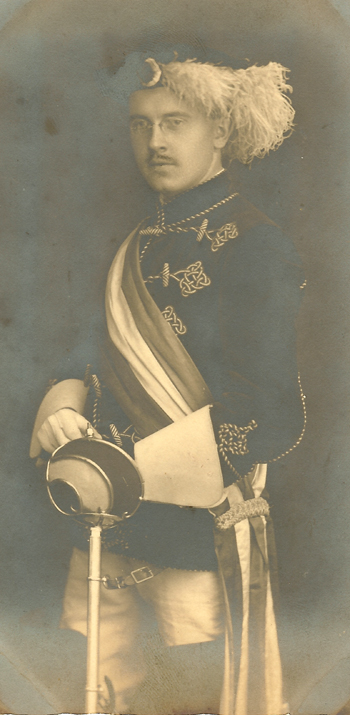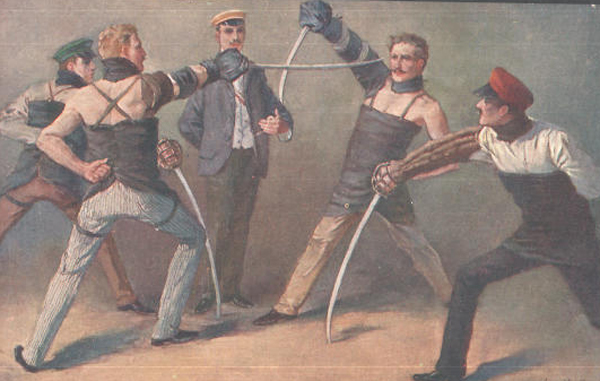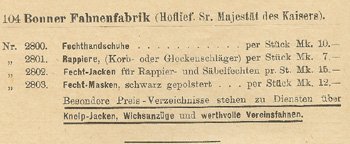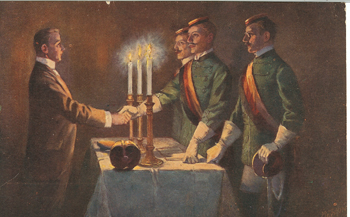Joseph Robinson
19 September 2006
 |
|
 |
We have all seen these pictures. Students with swords generally dismissed as some sort of university fraternity. The intent of this article is not academic, but merely to bring collectors some knowledge about what this was all about. I certainly did not know and have had a lot of fun looking it up. There is not a lot of data in the pickelhaube references on this subject.(There was one short article on page 16-19 of the June 1998 issue of the Uhlan.) Nonetheless the pictures abound, and seem to come up often when looking at photographs. With the exception of military officers, almost every prominent man in German public life has belonged to a student fraternity, from the great chancellor downwards. However, these fraternities were male bastions where one could prove himself and show that he was not afraid of bodily harm and would not flinch when his honor was tested. |
| Each of us has a doctrinal view of what dueling is all about. A pistol duel can be easily visualized with two antagonists, each one trying to harm the other or even kill the other. Sword duels can be visualized two antagonists dancing back and forth in a ballet of thrusts. What the student dueling societies did was something entirely different. In dead earnest the students entered into something known as the Mensur. Dueling was a social institution in Germany. The honor code of nobility must be maintained. Wilhelm II declared that he would punish any officer who fought a duel, but would dismiss from the army any one who refused to do so. Satisfaction in dueling was showing the world that you had no fear just great honor. | |
| Student societies can trace their roots back to the Middle Ages. For our purposes, we will talk about three kinds of student fraternities extending from the mid-1800s to the start of World War I. Remember that almost nobody went to the university. Of those that did about 25% were in fraternities. The others were “savages”. The expense was immense and the requirements rather stiff. Applicants needed to have an Abitur certificate before attending. Therefore, the students we are talking about are the upper crust of professionals both aristocratic and upper bourgeois. The students were destined to fill the ranks of professionals throughout Imperial Germany. While these individuals did not directly enter into the military, there was still a great social value into proving one’s worth and bravery. In order to do this students would go to university, and frequently join a group of fellows. Known as a Burschenschaft, this group of fellows or a fraternity, took on three general forms. The first kind was a Landsmannschaft. They tended to be regional fraternities based on geographic location and tended to be more liberal. The second kind was a more normal Burschenschaft. These were national in nature and tended to be more right wing politically. The third kind was called a Korps. These tended to be more aristocratic in nature, and a discussion of politics was strictly prohibited. Amongst these three levels. There were dueling fraternities and non-dueling fraternities. The Catholic Church had prohibited the Mensur and generally the Catholic fraternities did not duel. there were a lot of fraternities. At one point it was noted to be more than 4000 different fraternities. The Stein collectors have in general given up in trying to identify all of the different branches. There was a book written in the 1930s that actually listed 1400 different coats of arms. | 
|

|
The use of Landsmannschaft, Burschenschaft, and Korps are often interchanged in literature. The different groups can be separated by their style of uniform, hat, and a brightly colored sash done in the colors of that fraternity. However all three of these had several things in common. There were generally three kinds of members. Membership was lifelong and alumni played an active role in the chapter. The first kind of member was irregular member. Irregular members were those who were physically unable to participate in a Mensur or whose parents refused to allow them to participate in a Mensur. The second type of member was a novice, also known as a pledge in the English language fraternities. The novices were also known as Foxes. They had not yet earned the right to participate in a Mensur. Typically, a new fox/pledge is not allowed to participate in the Mensur until after having completed one and a half to two terms of study, involving about one hour of fencing study daily instructed by the Burschenschaft ‘fencing master’. Some Burschenschaft had a shorter period of being a novice. The third kind of member, or Burschen, are full-fledged Korps students, eligible to become officers. Once again, there are three officers, called respectively the first, second and third, ‘in charge.’ The first is the chief, who presides at formal meetings and in the drinking-hall, where the Korps assembles officially on two evenings of the week. The second in charge manages all affairs relative to fighting, and is personally responsible to the association for all formalities relating to the duels of its members. The third in charge is secretary and treasurer. In most Burschenschaft, the president considered himself morally bound to see that all the members attend their lectures regularly. |
| Each novice is considered to be personally under the charge of one of the fellows, whose duty it is to keep him out of trouble and to be a role model. In addition, there was a position known as “Fox-Major”. This individual was in charge of all of the novices and provide instruction about the fraternity on a weekly basis. This individual wore a distinctive headpiece regularly adorned with fox accoutrements and would forever be allowed to use the initials “FM” after his signature. |  |
 |
Fraternity life consisted of many jovial gatherings. There were ritual meetings and methods for drinking beer. One common device was called a Salamander. The top officer would open meetings with a salamander, where beer mugs would be slid along the table and then pounded in unison three-times. This device was used for opening and closing meetings as well as numerous toasts. There were also such things as beer duels. A full glass two opponents chug the brew and the winner is he who empties the glass first. The President can order any member to drink a quantity of beer as a punishment. Any full member can direct a novice to do the same thing. (As a side note, most fraternity houses had something called a Kotzbecken or puking sink. This practical device came up to just under chest level and had support bars on the wall to hold you up.) Singing was another indispensable part of every regular meeting. All members had song books and the songs tended to be patriotic. |
| Fencing | |
| The student Mensur is completely foreign to the idea of American doctrinal dueling. The two antagonists are not enemies, and often become close friends after the duel. There is no endeavor to kill one another. And most different of all there is no movement. The only allowed movement is the sword arm itself. The participant is known as Der Herr Paukant. The duel is always between two different fraternities. This is seldom conducted to overcome some slight, but rather to fulfill the requirements the fraternities place on dueling. Let us take a look at a picture of the Paukant. |  |
| The first thing to look at is the sword. This is known as the Schlager. The typical ‘Schlager’ (‘basket racquet’) used has a blade about 85 cm long and at least 1 cm wide (last 8″ sharpened). It has a conspicuous ‘basket grip’ that protects the hand and is typically decorated in the ‘couleurs’ of the student Burschenschaft the ‘Paukant’ belongs to. It is peculiar to a specific type of saber dueling. In swordplay there are basically two types of damage systems. “Impact” fencing (use of a blade to pierce mortally) and “blow” fencing (use of a blade to strike). The weapons used for the ‘evolved’ form of ‘blow fencing’ (“schlaeger fechten”) known as the ‘Mensur’ came to be commonly known in Germany as ‘racqueten’. The dueling sword differed from the Mensur racquet only in the nature of the blade, which on the former was curved and somewhat heavier. These two parallel forms of individual sword interaction grew largely side by side. The first consisting of actual dueling with sharp, pointed saber blades, the other consisting of the ‘Mensur’ (or ritualized fencing), with the ‘basket racquet’ (“Korbschlaeger”) or the ‘bell racquet’ (“Glockenschlaeger”). The picture below shows a normal duel. Notice that heavier sword and the movement. This is often confused with a student Mensur. | |
 |
|
 |
The Paukant also wore protective clothing that included reinforced leather aprons, arm coverings, neck protection, and steel ‘goggles’ to protect the eyes. The head and face are left totally unprotected.
|
 |
|
 |
|
| Continuing on to the duel itself each Paukant pair was separated by their seconds by one saber length or about 3 feet. The seconds then stood to the left of the Paukant. This distance was known as the Mensurabstand. A Paukant was not allowed to shorten or lengthen this distance. A Paukant was not allowed to back off or shift position. The left hand was placed behind the back, and the right hand held up in one of two general positions. The offensive position (left hand Paukant above.) was known as the Hochquart or high quart. This allowed one to strike down from a position of safety. The defensive position (Paukant on right above.) was known as the steile Auslage, or Steep Ward. Both of these positions protected the right side of the face. It was very possible to go through an entire Mensur completely protected. However, that required almost perfect execution. A major fault of the picture above is that the participants are too far apart. They should be separated by only one sword length and then also have the length of their arms. This brings up an interesting physics problem that the point of the sword is often several feet behind the opponents back. | |
 |
Much importance is placed upon the perfect maintenance of stance of the participant, since moving to avoid blows with the body or foot is forbidden (“Mucken” or ducking.); moreover, such movement is considered cowardly and may be cause for premature cessation of the Mensur. 40 courses are considered the norm for completion of the Mensur, 15 courses for a Fox. A “course” (Gang) is a predefined amount of strikes. Always under ten and usually around four. The seconds kept track of them. If either of the ‘Paukant’ receive ‘Schmisse’ that are particularly serious, the contest may be considered satisfactorily completed at the discretion of the attending physician (known as ‘Bader’). In that event the ‘Schmiss’ will be sutured on site, although without local anesthetic!
|
| For a student and all of German Society, the badge of courage was the Schmiss (The dueling scar, or sometimes called the Renommierschmiss, or bragging scar), mostly on the left side of the face, where blows would fall from a right-handed duelist. This was borne by a generation of doctors, jurists, professors and officials, certifying the owner’s claim to manly stature. The dueling scar was certain to attract attention because it signified courage and breeding. There are stories that students would resort to self-infliction with a razor. Those who received their Schmiss in this less honorable way would frequently enhance it by pulling the wound apart and irritate it by pouring in wine or sewing horse hair into the gash.
|

|
 |
A picture of a famous Nazi showing a horrible scar on his left cheek. It was a Schmiss. |
| Another example of a Schmiss, this one from the collection of Mike Huxley. Stories relate that females were attracted to people with such a scar. Somehow I doubt that. I just cannot imagine my wife waking up next to this face and thinking it is a bonus. |  |
| Comments by Readers | |
| A few corrections have come from various sources. This first one is from a former Fox Major. | “You should add to different groups of student societies the TURNERSDCHAFT. The Turnerschafts were establishes about 1819 and form a fraternity of patriotism, not nationalism and not chauvinism. The Nazis dissolved all student societies in order to establish their ideology. Duels and fencing was not allowed any longer. After 1950 most student societies founded their tradition again. By the way I fought seven duels and still have some scars on my head (with hair over) My corporation’s name is Turnerschaft Salia Jenensis, as you will remember.” |
| From an American observer. | I recall visiting XXXXX at Gottingen University and there was a formal vote taken by both corporations involved in the duel to allow me to be present as an observer. Because I had just returned from infantry and cavalry combat in Vietnam they invited me to watch. My memory was of how sharp the swords were and that the blades had to be straightened after each series of blows. During the duel of rapid blows it seemed I saw a piece of hair fall to the floor followed by a flow of blood from the head wound. Time out was then called and a doctor examined the wound. It was necessary for all the corporation members to vote to end a duel should their entrant be badly wounded. |
| A German citizen here in modern times. This was posted in AHF | I’m a member in a “Corps” named “Corps Cheruscia” Berlin in the WSC “Weinheimer Senioren Convent” , one of the German wide umbrella organisations for duty Mensur. I have fought 6 “Mensuren” from 1991 to 1994, without a “Schmiss” in my face, but the fights were hard on the other side – yeah, I was the winner in 3 fights, I lost 1 fight and 2 fights ended in a draw. I can describe every aspect of the student “Mensur”.a little mistake: your picture “Fencing” is not a fencing. Its a “Landesvater- Stechen” – take your student cap and hold it, that your best friend in the Corps can transfixing your cap with his “Schläger”, our swords. You can do the same thing with his cap. Than clasp his hand to pledge troth. This is a old ritual to pledge troth to the leader of the German countries in the middle age, because the students at the universities were associated in country groups till the end of 1815/ 1830. After the “Landesvater” you can request your girlfriend to embroider the slit in the cap with silver or gold yarn. A Landesvater is a special event all 5 years. Please note that every town has a special fight rule. You have to learn the typical town rule to fight in this town. |
| We have two catalogs with many items for sale for students. I was surprised that there were not as many pictures as I would have liked. it seems as though the restrictions on dueling restricted the amount of kitsch available for sale. |  |
 |
 |
 |
|
 |
|







